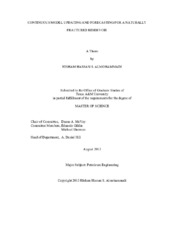| dc.description.abstract | Recent developments in instrumentation, communication and software have enabled the integration of real-time data into the decision-making process of hydrocarbon production. Applications of real-time data integration in drilling operations and horizontal-well lateral placement are becoming industry common practice. In reservoir management, the use of real-time data has been shown to be advantageous in tasks such as improving smart-well performance and in pressure-maintenance programs. Such capabilities allow for a paradigm change in which reservoir management can be looked at as a strategy that enables a semi-continuous process of model updates and decision optimizations instead of being periodic or reactive. This is referred to as closed-loop reservoir management (CLRM).
Due to the complexity of the dynamic physical processes, large sizes, and huge uncertainties associated with reservoir description, continuous model updating is a large-scale problem with a highly dimensional parameter space and high computational costs. The need for an algorithm that is both feasible for practical applications and capable of generating reliable estimates of reservoir uncertainty is a key element in CLRM.
This thesis investigates the validity of Markov Chain Monte Carlo (MCMC) sampling used in a Bayesian framework as an uncertainty quantification and model-updating tool suitable for real-time applications. A 3-phase, dual-porosity, dual-permeability reservoir model is used in a synthetic experiment. Continuous probability density functions of cumulative oil production for two cases with different model updating frequencies and reservoir maturity levels are generated and compared to a case with a known geology, i.e., truth case.
Results show continuously narrowing ranges for cumulative oil production, with mean values approaching the truth case as model updating advances and the reservoir becomes more mature. To deal with MCMC sampling sensitivity to increasing numbers of observed measurements, as in the case of real-time applications, a new formulation of the likelihood function is proposed. Changing the likelihood function significantly improved chain convergence, chain mixing and forecast uncertainty quantification. Further, methods to validate the sampling quality and to judge the prior model for the MCMC process in real applications are advised. | en |


